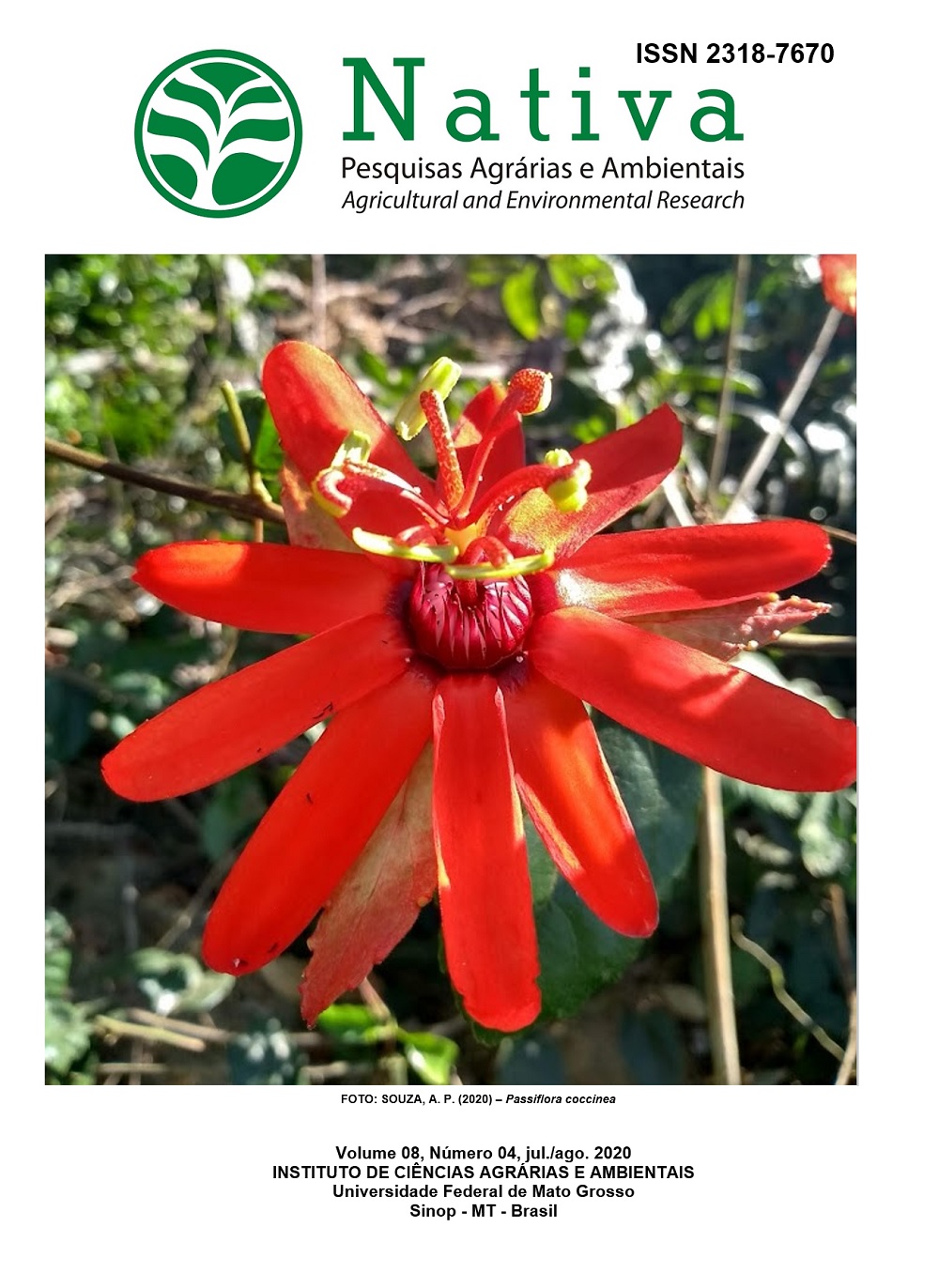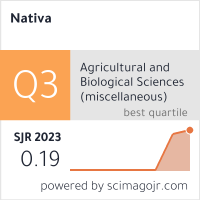MICRORGANISMOS E SEUS PRODUTOS DE FERMENTAÇÃO INTERFEREM NA QUALIDADE DE SEMENTES E PLÂNTULAS DE MILHO?
DOI:
https://doi.org/10.31413/nativa.v8i4.9498Resumo
A microbiota do solo e suas funções ecológicas são responsáveis por relações diretas e indiretas com a planta. Objetivou-se avaliar a sanidade e germinação em sementes de milho, bem como a emergência e desenvolvimento de plântulas submetidas a microrganismos capturados de dois ambientes. Sementes de milho foram inoculadas ou irrigadas com microrganismos e seus produtos de fermentação, provenientes de duas áreas (mata ou cultivo de cana-de-açúcar) sob diferentes concentrações e avaliadas quanto a porcentagem de germinação, índice de velocidade de germinação, sanidade em teste em BOD, além da emergência, altura de plântula, massa de matéria seca da parte aérea e raiz e volume de raiz em ensaios em bandejas com solo. Não houve comprometimento na germinação, independentemente do tratamento utilizado. Houve a mitigação de Aspergillus spp. e Penicillium spp., porém, a potencialização de Fusarium spp em condições de laboratório sob aplicação de 50 e 100% de microrganismos capturados da área de mata e cana. De forma geral, houve efeito negativo da aplicação do tratamento sobre os parâmetros fisiológicos, provocados provavelmente por desequilíbrio na ecologia microbiana associado a sementes e plântulas.
Palavras-chave: Fusarium spp.; microrganismos eficientes; ecossistemas.
DO MICROORGANISMS AND THEIR FERMENTATION PRODUCTS INTERFER ON SEED AND SEEDLINGS CORN QUALITY?
ABSTRACT: Soil microbiota and its ecological functions are responsible for direct and indirect relations with the plant. The aim of this study was to evaluate the corn seeds health and germination and seedling emergence and development submitted to microorganisms captured from two environments. Corn seeds were inoculated or irrigated with microorganisms and their fermentation products, coming from two areas (forest or sugarcane cultivation) under different concentrations and evaluated for the germination percentage, germination speed index, health in test in BOD, seedling emergence, seedling height, shoot and root dry matter mass, and root volume in soil tray tests. There was no effect on germination, regardless of the treatment used. There was mitigation of Aspergillus spp. and Penicillium spp., but the increase of Fusarium spp occurrence in laboratory conditions under concentration of 50 and 100% of microorganisms captured from the forest and sugarcane areas. In general, there was a negative effect of all treatments on physiological parameters, probably caused by an imbalance in the microbial ecology associated with seeds and seedlings.
Keywords: Fusarium spp.; efficient microorganisms; ecosystems.
Referências
ACCINELLI, C.; MENCARELLI, M.; SACCÀ, M. L.; VICARI, A.; ABBAS, H. K. Managing and monitoring of Aspergillus flavus in corn using bioplastic-based formulations. Crop Protection, Guildford, v. 32, p. 30-35, 2012. DOI: https://dx.doi.org/10.1016/j.cropro.2011.10.006
BÁNKUTI, S. M. S.; BÁNKUTI, F. I. Gestão ambiental e estratégia empresarial: um estudo em uma empresa de cosméticos no brasil. Gestão & Produção, São Carlos, v. 21, n. 1, p. 171-184, 2014. DOI: http://dx.doi.org/10.1590/s0104-530x2014000100012
BANSAL, R. P.; BHATI, P. R.; SEN, D. N. Differential specificity in water imbibition of indian arid zone seeds. Biologia Plantarum, Praha, v. 22, n. 5, p.327-331, set. 1980. DOI: https://dx.doi.org/10.1007/bf02908976
BERENDSEN, R. L.; PIETERESE, C. M. J.; BAKKER, P. A. H. M. The rhizosphere microbiome and plant health. Trends In Plant Science, Oxford, v. 17, n. 8, p.478-486, 2012. DOI: https://dx.doi.org/10.1016/j.tplants.2012.04.001
BRASIL_MINISTÉRIO DA AGRICULTURA, PECUÁRIA E DO ABASTECIMENTO. Instrução Normativa n° 45, de 17 de setembro de 2013. 22 p.
CALERO-HURTADO, A.; QUINTERO-RODRÍGUEZ, E.; PÉREZ-DÍAZ, A.; OLIVERA-VICIEDO, D.; PEÑA-CALZADA, K.; JIMÉNEZ-HERNÃNDEZ, J. Efecto entre microorganismos eficientes y fitomas-e en el incremento agroproductivo del frijol. Biotecnología En El Sector Agropecuario y Agroindustrial, Popayán, v. 17, n. 1, p. 20-33, 2019.
CHAPARRO, J. M.; BADRI, D. V.; VIVANCO, J. M. Rhizosphere microbiome assemblage is affected by plant development. The ISME Journal, v. 8, n. 4, p.790-803, 2013. DOI: https://dx.doi.org/10.1038/ismej.2013.196
COLLA, L. M.; PRIMAZ, A. L.; LIMA, M.; BERTOLIN, T. E.; COSTA, J. A. V. Isolamento e seleção de fungos para biorremediação a partir de solo contaminado com herbicidas triazínicos. Ciência e Agrotecnologia, Lavras, v. 32, n. 3, p. 809-813, 2008. DOI: http://dx.doi.org/10.1590/s1413-70542008000300016
DARISSA, O.; ADAM, G.; SCHÄFER, W. A dsRNA mycovirus causes hypovirulence of Fusarium graminearum to wheat and maize. European Journal of Plant Pathology, Dordrecht, v. 134, n. 1, p. 181-189, 2012. DOI: https://dx.doi.org/10.1007/s10658-012-9977-5
FERREIRA, E. P. B.; STONE, L. F.; MARTIN-DIDONET, C. C. G. Population and microbial activity of the soil under an agro-ecological production system. Revista Ciência Agronômica, Fortaleza, v. 48, n. 1, p. 22-31, 2017. DOI: https://dx.doi.org/10.5935/1806-6690.20170003
FU, L.; PENTON, R.; RUAN, Y.; SHEN, Z.; CHAO, X.; LI, R.; SHEN, Q. Inducing the rhizosphere microbiome by biofertilizer application to suppress banana Fusarium wilt disease. Soil Biology and Biochemistry, Elmsford, v. 104, p.39-48, 2017. DOI: https://dx.doi.org/10.1016/j.soilbio.2016.10.008
GHADERI-FAR, F.; GHEREKHLOO, J.; ALIMAGHAM, M. Influence of environmental factors on seed germination and seedling emergence of yellow sweet clover (Melilotus officinalis). Planta Daninha, Viçosa, v. 28, n. 3, p. 463-469, 2010. DOI: https://dx.doi.org/10.1590/s0100-83582010000300002
GIASSI, V.; KIRITANI, C.; KUPPER, K. C. Bacteria as growth-promoting agents for citrus rootstocks. Microbiological Research, Jena, v. 190, p.46-54, 2016. DOI: https://dx.doi.org/10.1016/j.micres.2015.12.006
HE, A.; KIU, J.; WNAG, X.; ZHANG, Q.; SONG, W.; CHEN, J. Soil application of Trichoderma asperellum GDFS1009 granules promotes growth and resistance to Fusarium graminearum in maize. Journal of Integrative Agriculture, v. 18, n. 3, p.599-606, 2019. DOI: https://dx.doi.org/10.1016/s2095-3119(18)62089-1
HENNING, F. A.; JACOB JUNIOR, E. A.; MERTZ, L. M.; PESKE, S. T. Qualidade sanitária de sementes de milho em diferentes estádios de maturação. Revista Brasileira de Sementes, v. 33, n. 2, p. 316-321, 2011. DOI: http://dx.doi.org/10.1590/s0101-31222011000200014
JANSSEN, E.; MOURITS, M. H. J.; FELS-KLERX, V. D.; LANSINK, A. O. Pre-harvest measures against Fusarium spp. Infection and related mycotoxins implemented by Dutch wheat farmers. Crop Protection, Guildford, v. 122, p. 1-34, 2019. DOI: https://dx.doi.org/10.1016/j.cropro.2019.04.005
KRISHNAN, N.; VELRAMAR, B.; VELU, R. K. Investigation of antifungal activity of surfactin against mycotoxigenic phytopathogenic fungus Fusarium moniliforme and its impact in seed germination and mycotoxicosis. Pesticide Biochemistry and Physiology, San Diego, v. 155, p. 101-107, 2019. DOI: https://dx.doi.org/10.1016/j.pestbp.2019.01.010
MAXIMIANO, C. V.; CARMONA, R.; SOUZA, N. O. S.; ALENCAR, E. R. de; BLUM, L. E. B. Physiological and sanitary quality of maize seeds preconditioned in ozonated water. Revista Brasileira de Engenharia Agrícola e Ambiental, Campina Grande, v. 22, n. 5, p. 360-365, 2018. DOI: https://dx.doi.org/10.1590/1807-1929/agriambi.v22n5p360-365
MOHAMMED, B. L.; HUSSEIN, R. A.; TOAMA, F. N. Biological control of Fusarium wilt in tomato by endophytic rhizobactria. Energy Procedia, v. 157, p. 171-179, 2019. DOI: https://dx.doi.org/10.1016/j.egypro.2018.11.178
MORAES, M. C. H. S.; MEDEIROS, E. V.; ANDRADE, D. S.; LIMA, L. D.; SANTOS, I. C. S.; MARTINS FILHO, A. P. Microbial biomass and enzymatic activities in sandy soil cultivated with lettuce inoculated with plant growth promoters. Revista Caatinga, Mossoró, v. 31, n. 4, p. 860-870, 2018. DOI: https://dx.doi.org/10.1590/1983-21252018v31n408rc
MOWA, E.; MAASS, E. The effect of sulphuric acid and effective micro-organisms on the seed germination of Harpagophytum procumbens (devil's claw). South African Journal of Botany, Pretoria, v. 82, p. 193-199, 2012. DOI: https://dx.doi.org/10.1016/j.sajb.2012.05.006
NIU, B.; PAULSON, J. N.; ZHENG, X.; KOLTER, R. Simplified and representative bacterial community of maize roots. Proceedings of the National Academy of Sciences of the United States of America, Washington, v. 114, n. 12, p. 2450-2459, 2017. DOI: https://dx.doi.org/10.1073/pnas.1616148114
PARIKH, L.; KODATI, S.; ESKELSON, M. J.; ADESEMOYE, A. O. Identification and pathogenicity of Fusarium spp. in row crops in Nebraska. Crop Protection, Guildford, v. 108, p. 120-127, 2018. DOI: https://dx.doi.org/10.1016/j.cropro.2018.02.019
PEDROZO, A.; OLIVEIRA, N. J. G.; ALBERTON, O. Biological nitrogen fixation and agronomic features of soybean (Glycine max (L.) Merr.) crop under different doses of inoculant. Acta Agronómica, Palmira, v. 67, n. 2, p.297-302, 2018. DOI: https://dx.doi.org/10.15446/acag.v67n2.56375
RAMOS, D. P.; BARBOSA, R. M.; VIEIRA, B. G. T. L.; PANIZZI, R. C.; VIEIRA, R. D. Infecção por Fusarium graminearum e Fusarium verticillioides em sementes de milho. Pesquisa Agropecuária Tropical, Goiânia, v. 44, n. 1, p. 24-31, 2014. DOI: https://dx.doi.org/10.1590/S1983-40632014000100011
SAVIĆ, Z.; DUDAŁ, T.; LOC, M.; GRAHOVAC, M.; BUDAKOV, D.; JAJIĆ, I.; KRSTOVIĆ, S.; BAROŁEVIĆ, T.; KRSKA, R.; SULYOK, M. Biological Control of Aflatoxin in Maize Grown in Serbia. Toxins, v. 12, n. 3, p. 162, 2020. DOI: http://dx.doi.org/10.3390/toxins12030162
SANTOS, L. F.; LANA, R. P.; SILVA, M. C.; VELOSO, T. G..; KASUYA, M. C. M.; RIBEIRO, K. G. Effective microorganisms inoculant: diversity and effect on the germination of palisade grass seeds. Anais da Academia Brasileira de Ciências, v. 92, n. 1, p. 1-12, 2020. DOI: http://dx.doi.org/10.1590/0001-3765202020180426
TAHEUR, F. B.; KOUIDHI, B.; QURASHI, Y. M. A. A.; ABES, J. B. S; CHAIEB, K. Review: Biotechnology of mycotoxins detoxification using microorganisms and enzymes. Toxicon, Elmsford, v. 160, p. 12-22, 2019. DOI: https://dx.doi.org/10.1016/j.toxicon.2019.02.001
TOMAZI, Y.; BONOME, L. T. S.; SIQUEIRA, D. J.; MOURA, G. S.; FRANZENER, G. S. Métodos de assepsia em sementes de feijão. Revista Verde de Agroecologia e Desenvolvimento Sustentável, Pombal, v. 14, n. 2, p. 229-237, 2019. DOI: http://dx.doi.org/10.18378/rvads.v14i2.6353
USDA_UNITED STATES DEPARTAMENT OF AGRICULTURE. World Corn Harvest 2018/19 - 11° USDA Survey. Disponível em: <https://www.nass.usda.gov/Data_and_Statistics/index.php>. Acesso em: 23 jun. 2020.
VILELA, L.; MARTHA JUNIOR, G. B.; MACEDO, M. C. M.; MARCHÃO, R. L.; GUIMARÃES JUNIOR, R.; PULROLNIK, K.; MACIEL, G. A. Sistemas de integração lavoura-pecuária na região do Cerrado. Pesquisa Agropecuária Brasileira, Brasília, v. 46, n. 10, p. 1127-1138, 2011. DOI: https://doi.org/10.1590/S0100-204X2011001000003
Downloads
Publicado
Edição
Seção
Como Citar
Licença
Direitos Autorais para artigos publicados nesta revista são do autor, com direitos de primeira publicação para a revista. Em virtude de a aparecerem nesta revista de acesso público, os artigos são de uso gratuito, com atribuições próprias, em aplicações educacionais e não-comerciais.
A artigos publicados nessa revista, podem ser reproduzidos parcialmente ou utilizados como referência por outros autores, desde que seja cita a fonte, ou seja, a Revista Nativa.
Copyright for articles published in this journal are the authors, with first publication rights granted to the journal. The journal shows open access, and articles are free to use, with proper attribution, in educational and non-commercial.
The articles published in this journal may be reproduced in part or used as a reference by other authors, provided that the source is quoted.






